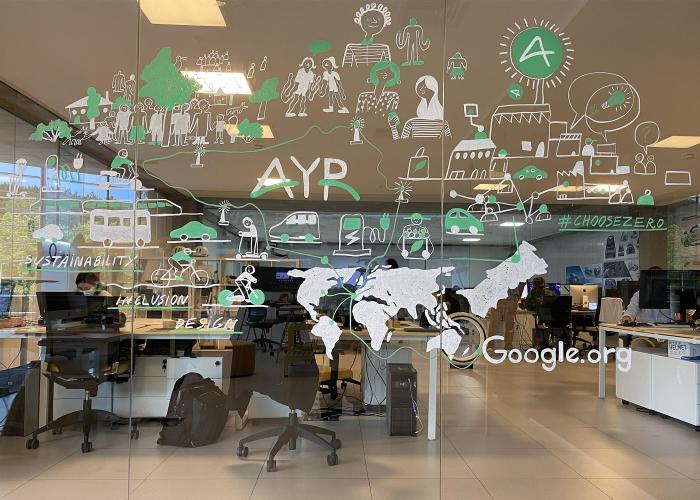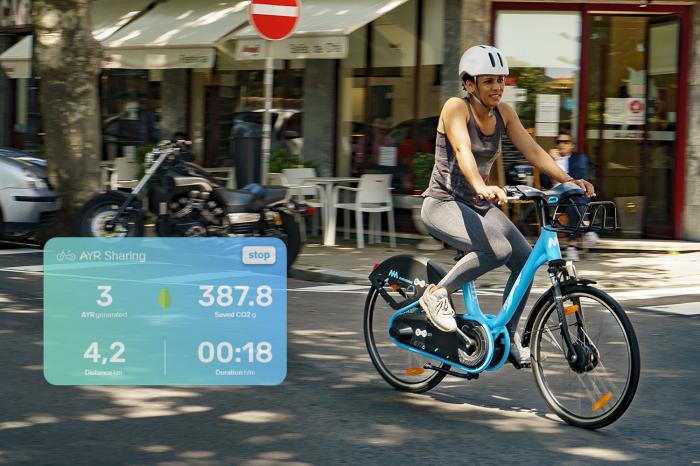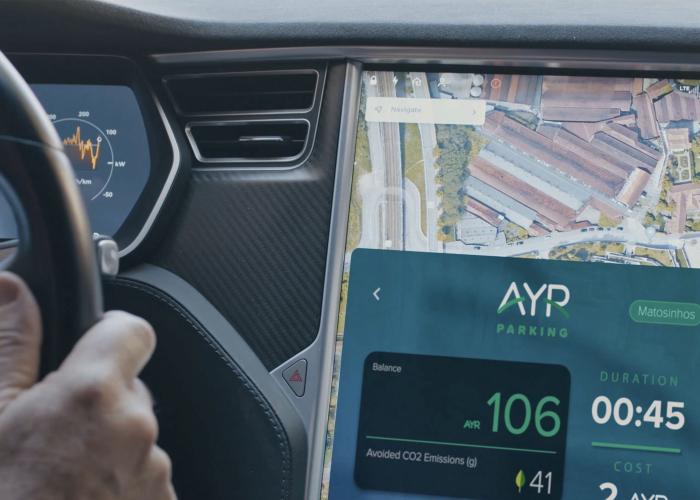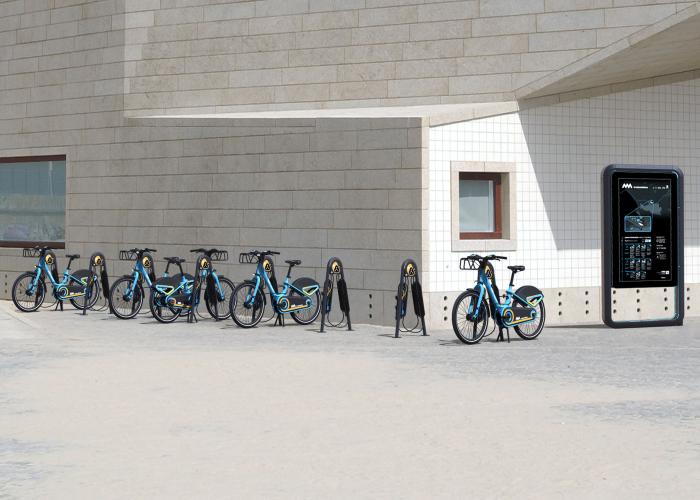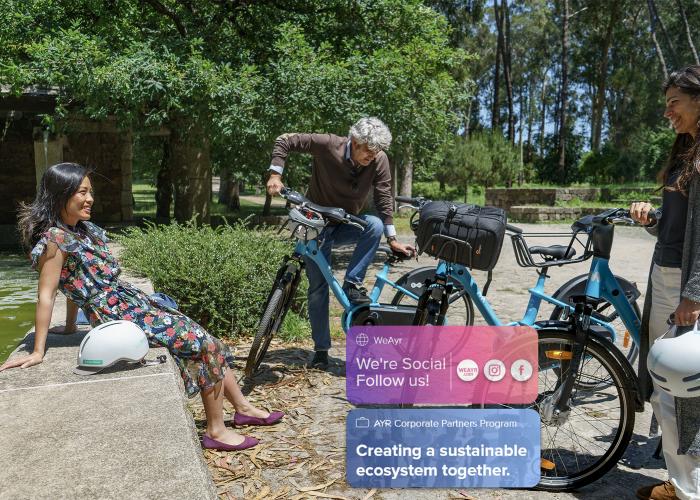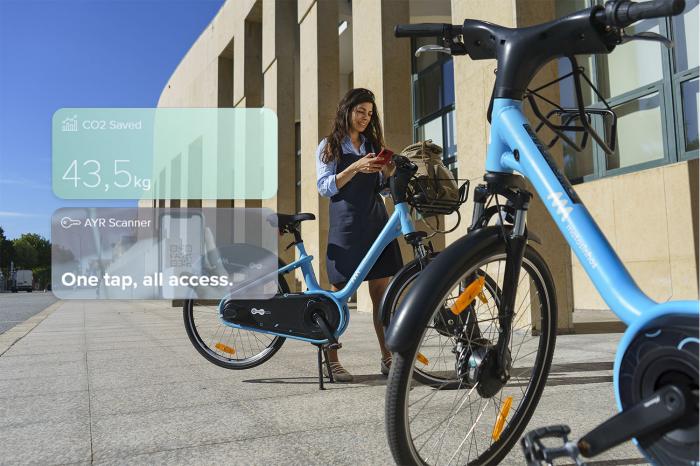I. SUMMARY INFORMATION
Project
269519
Status
Submitted
Award category
Products and life style
You want to submit
NEW EUROPEAN BAUHAUS AWARDS : existing completed examples
Project title
AYR sustainability platform
Full project title
AYR platform, an enabler to promote sustainable lifestyles
Description
AYR este o platformă bazată pe tehnologia blockchain care recompensează utilizatorii atunci când optează pentru o mobilitate ușoară. În prezent, este operațională în Matosinhos, unde municipalitatea, operatorii de mobilitate, întreprinderile și câțiva cetățeni au creat un ecosistem local pentru a-i încuraja pe cetățeni să renunțe la autoturisme și să opteze pentru mijloace de transport cu emisii scăzute și cu zero emisii (biciclete, biciclete electrice, scutere, mers pe jos, utilizare în comun a autoturismelor și transport public). Platforma măsoară cantitatea de CO2 pe care utilizatorii nu o produc atunci când aleg alternative la automobilele individuale. Aceste emisii nepoluante sunt convertite în tokenuri, un fel de credite verzi pe care utilizatorii le pot stoca într-un portofel digital și schimba apoi contra anumitor produse sau servicii. Întreprinderile își pot compensa emisiile de dioxid de carbon achiziționând credite verzi. Încasările sunt investite în proiecte locale de captare a dioxidului de carbon, de mobilitate durabilă și de economie circulară. Platforma utilizează datele pe care le colectează pentru a informa cetățenii și întreprinderile cu privire la amprenta lor de carbon. Un proiect-pilot derulat timp de 6 luni a avut ca rezultat o reducere de 18,1 tone de CO2 și a generat 181 000 de credite digitale.
Where was your project implemented in the EU?
Portugal
Porto
Avenida D. Afonso Henriques
Matosinhos
4454-510
When was your project implemented?
Has your project benefited from EU programmes or funds?
No
Which programme(s) or fund(s)? Provide the name of the programme(s)/fund(s), the strand/action line as relevant and the year.
II. DESCRIPTION OF THE PROJECT
Please provide a summary of your project
CEiiA is committed to co-imagine new ways of living together in cities, through transformative action. Our mission is to promote smart and sustainable living in Europe.
To achieve this goal, technology is not enough – our core challenges are behavioral and cultural. That’s why we have developed AYR, a sustainability platform designed to achieve a zero-carbon society, incentivizing the adoption of sustainable lifestyles.
AYR connects communities, people and things in a network, where sustainable actions create tokens that can be exchanged for green goods and services, or used to locally offset carbon emissions. The platform allows: 1) the quantification, in real time, of CO2 emissions avoided by citizens using a sustainable mobility mode; 2) the tokenization of the avoided CO2 emissions value into green digital credits, that are stored in the user’s digital wallet (an app); 3) the exchange of digital credits for green goods and services, creating a marketplace where tokens circulate as a sustainability coin; 4) the offset of local companies CO2 emissions through the purchase of these tokens, within a local voluntary carbon market. Financial receipts are used to invest in local green projects.
The platform uses data to produce information, making citizens and companies aware of their carbon footprint. A Climate Intelligence Centre manages all the collected data.
AYR is implemented in Matosinhos, where a local ecosystem has been co-created with municipalities, mobility operators, companies and citizens. Getting people out of cars onto mass transit, e-bikes or sidewalks, AYR contributes to revitalize urban neighborhoods, making them sustainable, inclusive and beautiful. Merging the physical and digital worlds, AYR induces new living experiences for all.
AYR is focused on the mobility sector, but it can induce new habits in other areas - energy, waste or food, empowering people to make sustainable choices. #choosezero is our challenge to citizens all over the world.
Please give information about the key objectives of your project in terms of sustainability and how these have been met
AYR intends to help Europe to achieve the Green Deal objectives: to reduce carbon emissions by 55% by 2030, and to achieve carbon neutrality by 2050. Recognizing the importance of cities, our solution aims to accelerate the transition towards carbon-neutral urban ecosystems. This is aligned with the Horizon Europe’s mission of creating 100 smart and carbon neutral cities by 2030.
To achieve these objectives, in a first phase AYR is centered on the mobility sector, because transports represent 25% of EU carbon emissions. A change of paradigm is needed, promoting the use of sustainable transport modes, such as public transports and soft modes. Using these mobility services, citizens avoid carbon emissions, which are converted into exchangeable tokens, rewarding their sustainable behavior.
Through the creation of local voluntary carbon markets, AYR allows companies to offset their carbon emissions, contributing to improve the sustainability of the territories. The receipts of selling digital credits to these companies are used to invest in local green projects, in several areas such as carbon capture, sustainable mobility or circular economy.
Car dependency has marginalized urban life, causing a chain of connected impacts: degraded public space, underperforming infrastructure networks, traffic congestion, and poorly planned spaces, increasing CO2 emissions. Incentivizing citizens to use sustainable mobility services instead of private vehicles, AYR helps to return public spaces to the communities, contributing to the creation of livable neighborhoods – green, inclusive and beautiful. Urban planning and design can act as enablers, supporting the creation of mixed-used places with less mobility needs - the concept of 15-minutes city.
We want to bring the Green Deal to people lives, because climate emergency requires a different way of thinking and acting, a mindset of transformation, a change in lifestyles. We are building Collective Intelligence for Sustainability.
Please give information about the key objectives of your project in terms of aesthetics and quality of experience beyond functionality and how these have been met
AYR deployment implies blending the physical and digital worlds, connecting communities, people and things. Mobility devices are linked to urban infrastructures and citizens, through digital platforms and user-interfaces.
Mobility products have been designed to be used as services, within a shared and connected economy, privileging the quality of living experiences. The design of these products is based on the following principles: circularity, functionality, simplicity, modularity and flexibility (sustainability by design). These products are also considered as open to changes and evolutions.
Twenty years ago, Buchanan supported a change in the designer's paradigm, moving away from visual symbols and things into an understanding of products inside the experience of human beings, making use of their social and cultural environments. Social aesthetics results from the involvement of AYR stakeholders in a digital urban community and generates sustainable lifestyles.
By decreasing car dependency and promoting the use of sustainable mobility modes, AYR contributes to create beautiful, sustainable and inclusive places, shared by citizens and communities. Mobility devices must be perfectly integrated in the urban environment, preserving public spaces. They should be moveable, adaptive and reconfigurable to changing life situations. The new aesthetics is an invisible feature, more than a visible statement. Reframing Dieter Rams’ design principles into contemporary approaches, we strive to make things transparent.
AYR user interfaces that connect data with products and services are functional, versatile, modular, and attractive, increasing the quality of users’ experience. Look and feel are the physical evidence of the interaction experiences, being simplicity a core value of our visual solutions.
We add product design solutions considering their beauty and visual impact in the urban environment, and service design digital interfaces that reflect the net zero message
Please give information about the key objectives of your project in terms of inclusion and how these have been met
An inclusive approach is privileged by AYR – by choosing sustainable mobility behaviors, individuals have the power to influence the fight against climate change, contributing to improve their cities.
AYR deployment implies the creation of communities. When people participate in a community that might be a company, neighborhood, or family, they build a sense of identity and belonging. These culture and values are essential to promote the AYR philosophy. The platform is also a new channel for environmental literacy and can reach all people, raising awareness about their carbon footprint.
Moreover, AYR contributes to accelerate the transition towards sustainable and inclusive mobility. Privileging shared transport modes (e.g. public transports, car-sharing, bike-sharing) results in the democratization of mobility – more accessible and affordable. Using mobility devices as a service instead of having the ownership of the vehicles contributes to higher inclusion and sustainability, and better public spaces. Mobility is an urban (human) right that should be available for all.
For example, CEiiA is also deploying the AYR platform in the City of Cascais, where a Mobility-as-a-Service system enables the interoperability of several services, public transports are free of charge for residents, and the bike-sharing system is managed by a municipal company, with lower costs to specific targets of the population (students, elderly, families, etc).
AYR inspires the development of new mobility products to be used as services, creating customized solutions with value-added for the communities. These new services contribute to take cars out of streets, leaving public spaces for citizens. For example, CEiiA is developing a microcar, light and zero emissions, integrated with the AYR platform, that will be used in a new model of sharing.
Aligned with the UN 2030 Agenda and the European Green Deal, our ambition is ‘don’t leave anyone behind’, claiming for a just transition.
Please give information on the results/impacts achieved by your project in relation to the category you apply for
AYR solution contributes to change citizens’ habits towards sustainable, attractive and inclusive lifestyles, in several areas of our daily life, having mobility as a starting point. But AYR can also induce behavioral change in other areas, such as energy, waste or food.
The deployment of AYR in the City of Matosinhos targeted 175,000 habitants, reaching 33% of this population and a modal shift towards sustainable modes equivalent to 21% of the km they travel. This is an important achievement, because in the Municipality 60% of trips are made by private car. A 6-month pilot has resulted in avoiding 18.1 tons CO2 and generating 181,000 digital credits.
Considering the current situation in Matosinhos, it is estimated that, when the solution is scaled up, 2,000 ton CO2 will be avoided each year in relation to the use of combustion cars. For 2030, estimations result in avoided 60,000 ton CO2, 600 million tokens generated, and € 12 million available for investment in carbon neutrality, if credits are purchased by local companies to offset their emissions.
AYR platform can also be implemented in a corporate environment. As a pilot case, we have tested the solution at CEiiA in collaboration with a group of employees, making available a fleet of e-bikes and scooters to be used by them in commuting trips. Using these mobility modes, they have avoided carbon emissions, which have been quantified in real time by the AYR platform. This value has been converted into green tokens, exchangeable for goods and services within our facilities, such as charging or parking electric vehicles.
CEiiA is working with local companies to replicate this model, creating communities of users of sustainable mobility modes. The tokens accumulated by these companies and their employees can be exchanged for green goods and services or used to locally offset their carbon emissions. Working with big employers we can reach more citizens, contributing to a larger adoption of sustainable lifestyles
Please explain the way citizens benefiting from or affected by the project and civil society have been involved in the project and what has been the impact of this involvement on the project
The implementation of the AYR platform is centered on a bottom-up approach, starting from the involvement of citizens and communities in the fight against climate change, through behavior change. Co-creation and human-centered design are core principles of AYR deployment.
Matosinhos has created a living lab for decarbonization, with the support of the Environmental Fund, to test and experiment low carbon solutions in real life context in the areas of mobility, energy, and circular economy. Within this framework, the AYR platform has been tested with strong user involvement, to promote the social adoption of related technologies, products and services.
In a first phase, pilot groups of testers were created, and focus groups and other engagement techniques (e.g. questionnaires) were used to obtain feedback from the users, promoting the optimization of the AYR solution. Reaching an enlarged community of users implied the involvement of local companies and organizations (such as the City Council, leading by the example). For example, using a bike-sharing service provided by the Municipality, public servants avoid carbon emissions, that are converted into tokens through the AYR platform. These credits can be exchanged for green goods and services or free time. The City Council can use the credits to offset locally produced carbon emissions, reducing its carbon footprint.
Moreover, our strategy includes the nomination of AYR ambassadors and AYR change makers in different neighborhoods, to disseminate the benefits of integrating the AYR community. AYR has been designed to empower people to make sustainable choices, impacting positively the transition towards carbon-neutral and inclusive cities.
Please highlight the innovative character of the project
The innovation character of the project is based on the integration of policy, governance, regulation, technology, and citizens’ involvement. In fact, AYR is a socio-cultural-technological innovation.
AYR is the first worldwide solution that assigns a value to avoided carbon emissions (‘valuing what is not emitted’). This intangible asset can be materialized into tokens (digital credits), that can be exchanged for green goods and services or used to locally offset carbon emissions.
Focusing on the local dimension of sustainability and the role of cities in the decarbonization process is also a differentiating factor of AYR. Bottom-up, decentralized and voluntary climate policies must complement top-down, centralized and regulated policies, imposed by national and European authorities. The creation of a digital-based local voluntary carbon market in Matosinhos is a pioneering initiative at global level. Moreover, the Climate Intelligence Centre, which manages, analyses, stores and allows the visualization of mobility, energy and climate data, is also a governance innovation.
AYR is based on creating Carbon-Zero Communities with strong citizens’ involvement, privileging a human-centered approach. It recognizes the importance of daily individual choices, empowering citizens to adopt sustainable lifestyles. In fact, urban technology depends on culture and values.
Emergent technologies have been used, namely Blockchain, Internet-of-Things (IoT), and Data Analytics in the development of the AYR platform. Blockchain ensures security, transparency and privacy of transactions. Connectivity between communities, people and things is assured by IoT. Finally, data collected by the AYR platform is analyzed and integrated, through data analytics and related technologies, and useful information and knowledge are generated to support decision-making and the definition of local policies for decarbonization.
Please explain how the project led to results or learnings which could be transferred to other interested parties
The results of the project can be transferred to other cities all over the world. Some adjustments are needed to fit AYR solution to local realities, but leveraging what already exists on the ground.
The initiative was tested and successfully implemented in the City of Matosinhos (PT). CEiiA is starting to replicate AYR solution in other 10 Portuguese cities in the framework of the Mobility Agenda of the Recovery and Resilience Plan delivered by the Portuguese Government to the EC.
Some pilots are already being implemented in Brazil (e.g. City of Itajai), and a cooperation agreement will be signed with ICLEI Latin America to expand the project to other cities.
In Europe, we are approaching some European capital cities with the support of Google.org within our successful application to the Climate Impact Challenge (Apr. 2021). It is also worth of notice that AYR was one of the five finalists of the Open Innovation Challenge launched by the City of Copenhagen to tackle pollution and the urban heat island effect (Nov. 2019).
The alignment of AYR with the 2030 Agenda and the Sustainable Development Goals (SDG) has been recognized by the United Nations in COP 21 (Paris) and COP 25 (Madrid), which is an accelerator to scale up the solution and reach cities all over the world.
Our ambition is to create a global network of AYR cities, contributing to accelerate the transition of Europe towards a sustainable and inclusive future. Using collective imagination, wisdom and creativity of people all over the world.
Is an evaluation report or any relevant independent evaluation source available?
III. UPLOAD PICTURES
IV. VALIDATION
By ticking this box, you declare that all the information provided in this form is factually correct, that the proposed project has not been proposed for the Awards more than once under the same category and that it has not been subject to any type of investigation, which could lead to a financial correction because of irregularities or fraud.
Yes
